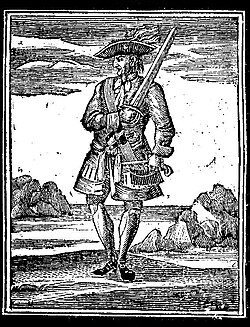| Capture of the sloop William | |||||||
|---|---|---|---|---|---|---|---|
| Part of the Golden Age of Piracy | |||||||
 An 18th century woodcut of Calico Jack | |||||||
| |||||||
| Belligerents | |||||||
|
|
| ||||||
| Commanders and leaders | |||||||
|
|
| ||||||
| Strength | |||||||
| 1 sloop-of-war | 1 sloop-of-war | ||||||
| Casualties and losses | |||||||
|
~3 wounded 1 sloop-of-war damaged |
1 killed 13 captured 1 sloop-of-war captured | ||||||
| |||||
The Capture of the sloop William refers to a small single ship action fought between Calico Jack's pirate ship and a British sloop-of-war from Port Royal, Jamaica. The battle was fought in Dry Harbor Bay, and ended with the capture of the famed pirate and his small crew of which several were hanged later on as a warning to other brigands.
Background[]
Calico Jack commanded William, a small but fast twelve-ton sloop during the action. Her armament was light, consisting of at least four cannon and at the time of battle carried a crew of fourteen including Jack and the pirates Mary Read and Anne Bonny. Calico Jack was originally a pirate under Captain Charles Vane but soon after turned to piracy. In 1719, he sailed to New Providence to receive a pardon and a letter of marque from Governor of New Providence Captain Woodes Rogers. The War of the Quadruple Alliance had begun and England hoped to make privateers of Caribbean brigands to fight the Spanish. Captain Jack was capable of receiving a pardon, but he did not receive a commission to attack the Spanish fleet.
Calico settled in New Providence, where he met Anne Bonny, but when his money was gone he returned to his life of crime. On August 22, 1719, Jack and eight men others captured William in Nassau harbor.
Governor of Jamaica, Nicholas Lawes, directed Captain Jonathan Barnet to take two privateer sloops on a mission to hunt him down. One, Snow-Tyger, was heavily armed with several guns and carried about twenty Royal Navy sailors and some British Army troops; the other was Mary Anne (under former pirate Jean Bonadvis[1]) which carried about twenty men. Bonadvis was the first to spot Rackham, who fired on him; Bonadvis then retreated to report Rackham's position to Barnet, but did not further participate in the battle. The encounter is remembered more for its participants than the actual combat.
Capture[]
It was around 10:00 at night on October 20, 1720 when Snow-Tyger discovered William at anchor in Dry Harbor Bay near the shore. William's crew was mostly drunk and sleeping, including Captain Rackham. Bonadvis approached William but fell back after Rackham fired a cannon at him.[1] Barnet then ordered his men to extinguish all lights and to silently approach the resting pirates. Once his sloop was near William, Barnet ordered the pirates to surrender. Captain Rackham awoke and the pirates on deck answered with a few shots from their swivel gun. Captain Barnet then ordered his ship to return a broadside and to close in and board the enemy.
The pirates immediately set sail, trying to flee, but most of the crew retreated into the cabins. William made it only a few yards before Snow-Tyger caught up with her and continued the boarding. Mary Read, Anne Bonny and another pirate remained on deck and attempted to fight off the attackers, but eventually surrendered. Angered by the cowardice displayed by her shipmates, Read killed one of her fellow pirates after witnessing the retreat into the cabin, which ultimately lost the battle. The boarding party stormed the cabins and the remaining pirates were captured along with the drunk Calico. A few British fighting men were wounded but none were killed in the quick action. Snow-Tyger sustained light damage to her sails and rigging and William suffered heavy damage to her poop.
Aftermath[]
Calico Jack and his crew were taken to Port Royal, where Jack and eleven others were tried on November 16 and hanged on November 19 and 20, 1720. Calico was disemboweled and his body placed in a cage and gibbeted on the small Deadman's Cay at the entrance of Port Royal. The remains of the other pirates were placed at various locations around the port. Mary Read and Anne Bonny avoided hanging by claiming that they were pregnant, Read died several months later before her scheduled execution, while Bonny was never heard from again. Some accounts say Bonny retired and settled in North America and others say she returned to piracy. Bonny spoke of Calico and reportedly said that "if he had fought like a man, he need not have been hanged like a dog", a now famous saying.
References[]
- ↑ 1.0 1.1 Woodard, Colin (2008) (in en). The Republic of Pirates: Being the True and Surprising Story of the Caribbean Pirates and the Man Who Brought Them Down. Orlando FL: Houghton Mifflin Harcourt. ISBN 0547415753. https://books.google.com/books?id=W5sIuoBrFwYC&printsec=frontcover#v=onepage&q&f=false.
- A General History of the Pyrates by Captain Charles Johnson (1724)
- Pringle, Peter, Jolly Roger: The Story of the Great Age of Piracy, Dover Publishing Company (2004)
- Lord Archibald Hamilton "An answer to an anonymous libel, entitled Articles exhibited against lord Archibald Hamilton, late governour of Jamaica" (1718)
The original article can be found at Capture of the sloop William and the edit history here.